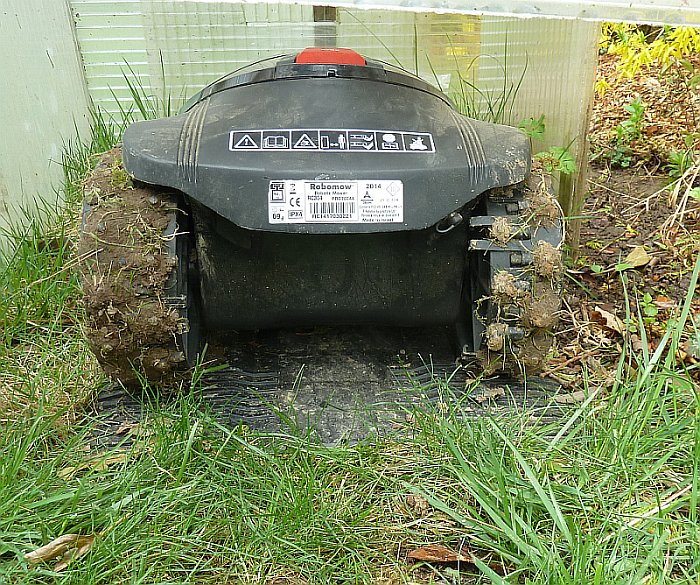Hallo Zusammen,
auf openweathermap.org kann man sich einen Account anlegen un danach mit einer simplen Abfrage eine 5-Tages Wetterforhersage zusenden lassen.
Wenn man den Ardumower über einen Raspi oder PC steuert, könnte man einen Mähplan für die nächsten Tage erstellen und z.B.: nur bei Sonneschein, oder wenn es nicht regnet mähen lassen.
Ich habe mal ein wenig mit dem Python API- "pyowm" gespielt...
Ausgabe:
auf openweathermap.org kann man sich einen Account anlegen un danach mit einer simplen Abfrage eine 5-Tages Wetterforhersage zusenden lassen.
Wenn man den Ardumower über einen Raspi oder PC steuert, könnte man einen Mähplan für die nächsten Tage erstellen und z.B.: nur bei Sonneschein, oder wenn es nicht regnet mähen lassen.
Ich habe mal ein wenig mit dem Python API- "pyowm" gespielt...
Code:
from pyowm import OWM
from pyowm import timeutils
print (timeutils.next_three_hours())
# Have a pro subscription? Then use:
# owm = pyowm.OWM(API_key='your-API-key', subscription_type='pro')
# Search for current weather in London (Great Britain)
def weatherForecast():
# Query for 3 hours weather forecast for the next 5 days over London
fc = owm.three_hours_forecast('London,UK')
f = fc.get_forecast()
print (f.get_reception_time())
print (f.get_interval())
print (len(f))
for weather in f:
print (weather.get_reference_time('iso'),weather.get_status(), weather.get_rain())
print ("will be rainy: ", fc.will_be_rainy_at(weather.get_reference_time('iso')))
print ("will be snowy: ", fc.will_be_snowy_at(weather.get_reference_time('iso')))
## observation = owm.weather_at_place('London,UK')
## w = observation.get_weather()
##
## print(w) # <Weather - reference time=2013-12-18 09:20,
## # status=Clouds>
##
## # Weather details
## print w.get_wind() # {'speed': 4.6, 'deg': 330}
## print w.get_humidity() # 87
## print w.get_temperature('celsius') # {'temp_max': 10.5, 'temp': 9.7, 'temp_min': 9.0}
## print w.get_rain()
if __name__ == '__main__':
owm = OWM('your-API-key') # You MUST provide a valid API key
weatherForecast()Ausgabe:
Code:
('2018-04-15 12:00:00+00', u'Clear', {})
('will be rainy: ', False)
('will be snowy: ', False)
('2018-04-15 15:00:00+00', u'Clouds', {})
('will be rainy: ', False)
('will be snowy: ', False)
('2018-04-15 18:00:00+00', u'Rain', {u'3h': 0.03104})
('will be rainy: ', True)
('will be snowy: ', False)
('2018-04-15 21:00:00+00', u'Rain', {u'3h': 0.04834})
('will be rainy: ', True)
('will be snowy: ', False)
('2018-04-16 00:00:00+00', u'Rain', {u'3h': 0.15448})
('will be rainy: ', True)
('will be snowy: ', False)
('2018-04-16 03:00:00+00', u'Rain', {u'3h': 1.09462})
('will be rainy: ', True)
('will be snowy: ', False)
('2018-04-16 06:00:00+00', u'Rain', {u'3h': 0.15841})
('will be rainy: ', True)
('will be snowy: ', False)
('2018-04-16 09:00:00+00', u'Rain', {u'3h': 0.00406})
('will be rainy: ', True)
('will be snowy: ', False)
('2018-04-16 12:00:00+00', u'Rain', {u'3h': 0.03532})
('will be rainy: ', True)
('will be snowy: ', False)
('2018-04-16 15:00:00+00', u'Rain', {u'3h': 0.0944})
('will be rainy: ', True)
('will be snowy: ', False)
('2018-04-16 18:00:00+00', u'Rain', {u'3h': 0.03855})
('will be rainy: ', True)
('will be snowy: ', False)
('2018-04-16 21:00:00+00', u'Rain', {u'3h': 0.06703})
('will be rainy: ', True)
('will be snowy: ', False)
('2018-04-17 00:00:00+00', u'Rain', {u'3h': 0.01667})
('will be rainy: ', True)
('will be snowy: ', False)
('2018-04-17 03:00:00+00', u'Rain', {u'3h': 0.11761})
('will be rainy: ', True)
('will be snowy: ', False)
('2018-04-17 06:00:00+00', u'Rain', {u'3h': 0.01297})
('will be rainy: ', True)
('will be snowy: ', False)
('2018-04-17 09:00:00+00', u'Rain', {u'3h': 0.01722})
('will be rainy: ', True)
('will be snowy: ', False)
('2018-04-17 12:00:00+00', u'Clear', {u'3h': 5.0000000000106e-05})
('will be rainy: ', False)
('will be snowy: ', False)
('2018-04-17 15:00:00+00', u'Clear', {})
('will be rainy: ', False)
('will be snowy: ', False)
('2018-04-17 18:00:00+00', u'Clear', {})
('will be rainy: ', False)
('will be snowy: ', False)
('2018-04-17 21:00:00+00', u'Clear', {})
('will be rainy: ', False)
('will be snowy: ', False)
('2018-04-18 00:00:00+00', u'Clear', {})
('will be rainy: ', False)
('will be snowy: ', False)
('2018-04-18 03:00:00+00', u'Clear', {})
('will be rainy: ', False)
('will be snowy: ', False)
('2018-04-18 06:00:00+00', u'Clear', {})
('will be rainy: ', False)
('will be snowy: ', False)
('2018-04-18 09:00:00+00', u'Clear', {})
('will be rainy: ', False)
('will be snowy: ', False)
('2018-04-18 12:00:00+00', u'Clear', {})
('will be rainy: ', False)
('will be snowy: ', False)
('2018-04-18 15:00:00+00', u'Clear', {})
('will be rainy: ', False)
('will be snowy: ', False)
('2018-04-18 18:00:00+00', u'Clear', {})
('will be rainy: ', False)
('will be snowy: ', False)
('2018-04-18 21:00:00+00', u'Clear', {})
('will be rainy: ', False)
('will be snowy: ', False)
('2018-04-19 00:00:00+00', u'Clear', {})
('will be rainy: ', False)
('will be snowy: ', False)
('2018-04-19 03:00:00+00', u'Clear', {})
('will be rainy: ', False)
('will be snowy: ', False)
('2018-04-19 06:00:00+00', u'Clear', {})
('will be rainy: ', False)
('will be snowy: ', False)
('2018-04-19 09:00:00+00', u'Clear', {})
('will be rainy: ', False)
('will be snowy: ', False)
('2018-04-19 12:00:00+00', u'Clear', {})
('will be rainy: ', False)
('will be snowy: ', False)
('2018-04-19 15:00:00+00', u'Clear', {})
('will be rainy: ', False)
('will be snowy: ', False)
('2018-04-19 18:00:00+00', u'Clear', {})
('will be rainy: ', False)
('will be snowy: ', False)
('2018-04-19 21:00:00+00', u'Clear', {})
('will be rainy: ', False)
('will be snowy: ', False)
('2018-04-20 00:00:00+00', u'Clear', {})
('will be rainy: ', False)
('will be snowy: ', False)
('2018-04-20 03:00:00+00', u'Clear', {})
('will be rainy: ', False)
('will be snowy: ', False)
('2018-04-20 06:00:00+00', u'Clear', {})
('will be rainy: ', False)
('will be snowy: ', False)
('2018-04-20 09:00:00+00', u'Clear', {})
('will be rainy: ', False)
('will be snowy: ', False)
